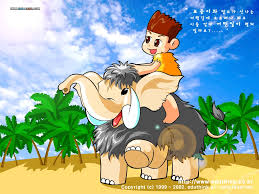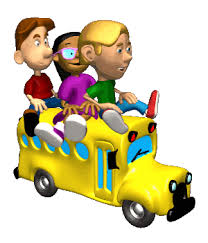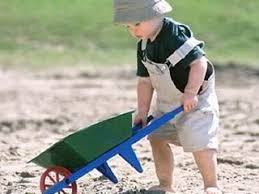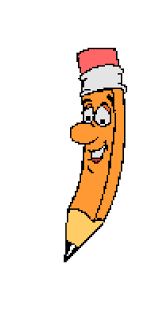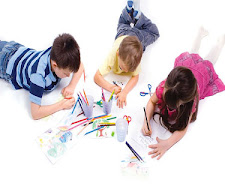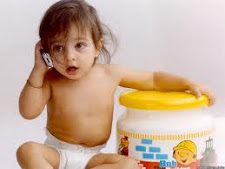I once wondered why some first graders were getting such answers as 3 + 4 = 4. By watching them, I found out that they were putting three counters out for the first addend and then four for the second addend, including the three that were already out.
Errors of this kind result from prematurely teaching a rule to follow. According to this rule, one must put counters out for the first addend, more counters for the second addend, and count all of them to get the answer. This rule works for children who already know that addition is the joining of two sets that are disjoint. However, the rule is superfluous for those who have constructed this logic, and it causes errors for those who have not constructed it.
Another example of imposing a rule that is either superfluous or premature is teaching counting-on to children who are counting-all. Counting-all refers to solving 3 + 4 by counting out three counters, then four other counters, and counting all of them again ("one-two-three-four-five-six-seven"). In counting-on, by contrast, children say "four-five-six-seven."
With scientific research replicated worldwide, Piaget showed that all children construct, or create, logic and number concepts from within rather than learn them by internalization from the environment (Piaget 1971; Piaget and Szeminska 1965; Inhelder and Piaget 1964; and Kamii 2000). Studying the research leads teachers to understand that addition involves part-whole relationships, which are very hard for children to make and which cannot be taught through practice and memorization. To add two numbers, children must put two wholes together ("three" and "four," for example) to make a higher-order whole ("seven") in which the previous wholes become two parts. When young children cannot think simultaneously about a whole and two parts, they count-all by changing both the "three" and the "four" into ones. Making them count-on is harmful when they cannot mentally make the part-whole relationship necessary to count-on.
When teachers study Piaget's theory and replicate the aforementioned research, they can understand why some first graders cannot count-on. When children have constructed their logic sufficiently to make the part-whole relationship of counting-on, they give up counting-all, just as babies give up crawling when they can walk. I hope that the day will come when teachers entering the classroom and those already in the classroom have as much scientific knowledge about how children learn mathematics as physicians have about the causes of illnesses. To reach this vision, the teacher-preparation programs must change.
When Children Learn Math Best
Children learn math best when they do so in “real world” situations, i.e., when they are using math to solve a real problem. That is why math games are an excellent method for children to learn math. Children are practicing the basics in a real world way. And, since the games are fun, children don’t even realize that they are practicing learning.
It's true that children learn a lot from things they are interested in. That Pokemon story or Harry Potter book, is helping develop their comprehension, vocabulary and many other literacy skills. This can also be true for children with learning disabilities.
Make sure your child can correctly write numerals. Even when children can count sequentially, they may have difficulties evidenced by reversing of numerals. Taking their hand in yours and tracing large numerals helps very much. Use a large, flat surface. Let your child get the "feet" of the shape. Try doing it with your child's eyes closed. Say the numeral as you trace it with him.
Before and after games, with numbers, are helpful for math understanding. First, know how far your child can sequentially count. Then ask, "What number comes after ?" and "What number comes just before. . . ?" This skill is critical for understanding both addition and subtraction.
Use numbers in a practical way around the house. "Susie, bring three forks to the table please;" or "Billy, will you give your dad five nails?" This gives children the opportunity to count in a realistic setting and to see, over and over again, that numerals in a problem at school represent real quantities. Use this activity in as many ways as you can.
Board games, which involve tossing of dice or spinning that result in a number of moves across a board, are excellent ways to develop sequential math understanding. These games are particularly helpful if there are backward moves as "penalties" in the game. You can even let your child make his own game by using a large sheet of construction paper. Dominoes are a good math activity because, besides being a game, the matching of numbers (in the simple form of the game) is required. Children see the dots, can orally name them, and then can make the correct match.
If numeral reversals continue, help your child with the understanding Of "left" and "right" on his own body. Play games like "Loobie-Loo" that require moving one side of the body or the other. The awareness of left and right also affects letter reversals as well.
Keeping score on games played at home. There are any number of activities that children can do at home winch require tallying. Mom and Dad might play a game, and the child can record points by using the style of clustering four straight (upright) lines with the fifth running diagonally. Then, he can figure the totals by counting by fives.
Give your child loads of opportunities to estimate space. This can be a family game if the conditions for involving other children are satisfactory. "How long do you suppose that table is?" Then it can be measured with a ruler or yardstick. The exact number of inches or feet is not critical. The question can be phrased so that the number of lengths is the critical factor. For example, "How many times would this ruler go across that table? You guess and I'll guess. Then we'll measure it. " You can practice estimating the distance across a room or up a wall, for example, in handprints, footsteps, paces, etc.
Measuring wall. Every home should have one wall that is used for keeping track of growth. Measure your child frequently and date each entry directly on the wall. Let him see how much he has grown as you measure him every month or every three months.
The same thing can be done with plants. There are many bulb plants that grow quickly in a pot or jar. Put a ruler beside the container and let your child record the amount of growth each day. He can, keep a chart, with your help, to determine the daily growth.
Why is it important for my child to learn math?
Math skills are important to a child’s success – both at school and in everyday life. Understanding math also builds confidence and opens the door to a range of career options.
- In our everyday lives, understanding math enables us to:
- manage time and money, and handle everyday situations that involve numbers (for example, calculate how much time we need to get to work, how much food we need in order to feed our families, and how much money that food will cost);
- understand patterns in the world around us and make predictions based on patterns (for example, predict traffic patterns to decide on the best time to travel);
- solve problems and make sound decisions;
- explain how we solved a problem and why we made a particular decision;
- use technology (for example, calculators and computers) to help solve problems.
How will my child learn math?
Children learn math best through activities that encourage them to:
- explore;
- think about what they are exploring;
- solve problems using information they have gathered themselves;
- explain how they reached their solutions.
Children learn easily when they can connect math concepts and procedures to their own experience. By using common household objects (such as measuring cups and spoons in the kitchen) and observing everyday events (such as weather patterns over the course of a week), they can "see" the ideas that are being taught.
An important part of learning math is learning how to solve problems. Children are encouraged to use trial and error to develop their ability to reason and to learn how to go about problem solving. They learn that there may be more than one way to solve a problem and more than one answer. They also learn to express themselves clearly as they explain their solutions.
At school, children learn the concepts and skills identified for each grade in the Ontario mathematics curriculum in five major areas, or strands, of mathematics. The names of the five strands are: Number Sense and Numeration, Measurement, Geometry and Spatial Sense, Patterning and Algebra, and Data Management and Probability. You will see these strand names on your child’s report card. The activities in this guide are connected with the different strands of the curriculum.
What tips can I use to help my child?
- Be positive about math!
- Let your child know that everyone can learn math.
- Let your child know that you think math is important and fun.
- Point out the ways in which different family members use math in their jobs.
- Be positive about your own math abilities. Try to avoid saying "I was never good at math" or "I never liked math".
- Encourage your child to be persistent if a problem seems difficult.
- Praise your child when he or she makes an effort, and share in the excitement when he or she solves a problem or understands something for the first time.
Make math part of your child’s day.
- Point out to your child the many ways in which math is used in everyday activities.
- Encourage your child to tell or show you how he or she uses math in everyday life.
- Include your child in everyday activities that involve math – making purchases, measuring ingredients, counting out plates and utensils for dinner.
- Play games and do puzzles with your child that involve math.
They may focus on direction or time, logic and reasoning, sorting, or estimating.
- Do math problems with your child for fun.
- In addition to math tools, such as a ruler and a calculator, use handy household objects, such as a measuring cup and containers of various shapes and sizes, when doing math with your child.
Encourage your child to give explanations
- When your child is trying to solve a problem, ask what he or she is thinking. If your child seems puzzled, ask him or her to tell you what doesn't make sense. (Talking about their ideas and how they reach solutions helps children learn to reason mathematically.)
- Suggest that your child act out a problem to solve it. Have your child show how he or she reached a conclusion by drawing pictures and moving objects as well as by using words.
- Treat errors as opportunities to help your child learn something new.
What math activities can I do with my child?
1. Understanding Numbers
Numbers are used to describe quantities, to count, and to add, subtract, multiply, and divide. Understanding numbers and knowing how to combine them to solve problems helps us in all areas of math.
Count everything! Count toys, kitchen utensils, and items of clothing as they come out of the dryer. Help your child count by pointing to and moving the objects as you say each number out loud. Count forwards and backwards from different starting places. Use household items to practise adding, subtracting, multiplying, and dividing.
Sing counting songs and read counting books. Every culture has counting songs, such as "One, Two, Buckle My Shoe" and "Ten Little Monkeys", which make learning to count – both forwards and backwards – fun for children. Counting books also capture children’s imagination, by using pictures of interesting things to count and to add.
Discover the many ways in which numbers are used inside and outside your home. Take your child on a "number hunt" in your home or neighbourhood. Point out how numbers are used on the television set, the microwave, and the telephone. Spot numbers in books and newspapers. Look for numbers on signs in your neighbourhood. Encourage your child to tell you whenever he or she discovers a new way in which numbers are used.
Ask your child to help you solve everyday number problems. "We need six tomatoes to make our sauce for dinner, and we have only two. How many more do we need to buy?" "You have two pillows in your room and your sister has two pillows in her room. How many pillowcases do I need to wash?" "Two guests are coming to eat dinner with us. How many plates will we need?"
Practise "skip counting". Together, count by 2’s and 5’s. Ask your child how far he or she can count by 10’s. Roll two dice, one to determine a starting number and the other to determine the counting interval. Ask your child to try counting backwards from 10, 20, or even 100.
Make up games using dice and playing cards. Try rolling dice and adding or multiplying the numbers that come up. Add up the totals until you reach a target number, like 100. Play the game backwards to practise subtraction.
Play "Broken Calculator". Pretend that the number 8 key on the calculator is broken. Without it, how can you make the number 18 appear on the screen? (Sample answers: 20 – 2, 15 + 3). Ask other questions using different "broken" keys.
2. Understanding Measurements
We use measurements to determine the height, length, and width of objects, as well as the area they cover, the volume they hold, and other characteristics. We measure time and money. Developing the ability to estimate and to measure accurately takes time and practice.
Measure items found around the house. Have your child find objects that are longer or shorter than a shoe or a string or a ruler. Together, use a shoe to measure the length of a floor mat. Fill different containers with sand in a sandbox or with water in the bath, and see which containers hold more and which hold less.
Estimate everything! Estimate the number of steps from your front door to the edge of your yard, then walk with your child to find out how many there really are, counting steps as you go. Estimate how many bags of milk your family will need for the week. At the end of the week, count up the number of bags you actually used. Estimate the time needed for a trip. If the trip is expected to take 25 minutes, when do you have to leave? Have your child count the number of stars he or she can draw in a minute. Ask if the total is more or less than your child thought it would be.
Compare and organize household items. Take cereal boxes or cans of vegetables from the cupboard and have your child line them up from tallest to shortest.
Talk about time. Ask your child to check the time on the clock when he or she goes to school, eats meals, and goes to bed. Together, look up the time of a television program your child wants to watch. Record on a calendar the time of your child’s favourite away-fromhome activity.
Keep a record of the daily temperature outside and of your child’s outdoor activities. After a few weeks, ask your child to look at the record and see how the temperature affected his or her activities.
Include your child in activities that involve measurements. Have your child measure the ingredients in a recipe, or the length of a bookshelf you plan to build. Trade equal amounts of money. How many pennies do you need to trade for a nickel? for a dime?
3. Understanding Geometry
The ability to identify and describe shapes, sizes, positions, directions, and movement is important in many work situations, such as construction and design, as well as in creating and understanding art. Becoming familiar with shapes and spatial relationships in their environment will help children grasp the principles of geometry in later grades.
Identify shapes and sizes. When playing with your child, identify things by their shape and size: "Pass me a sugar cube." "Take the largest cereal box out of the cupboard."
Build structures using blocks or old boxes. Discuss the need to build a strong base. Ask your child which shapes stack easily, and why.
Hide a toy and use directional language to help your child find it. Give clues using words and phrases such as up, down, over, under, between, through, and on top of.
Play "I spy", looking for different shapes. "I spy something that is round." "I spy something that is rectangular." "I spy something that looks like a cone."
Ask your child to draw a picture of your street, neighbourhood, or town. Talk about where your home is in relation to a neighbour’s home or the corner store. Use directional words and phrases like beside and to the right of.
Go on a "shape hunt". Have your child look for as many circles, squares, triangles, and rectangles as he or she can find in the home or outside. Do the same with threedimensional objects like cubes, cones, spheres, and cylinders. Point out that street signs come in different shapes and that a pop can is like a cylinder.
4. Understanding Patterns
We find patterns in nature, art, music, and literature. We also find them in numbers. Patterns are at the very heart of math. The ability to recognize patterns helps us to make predictions based on our observations. Understanding patterns helps prepare children for the study of algebra in later grades.
Look for patterns in storybooks and songs.
Many children’s books and songs repeat lines or passages in predictable ways, allowing children to recognize and predict the patterns.
Create patterns using your body.
Clap and stomp your foot in a particular sequence (clap, clap, stomp), have your child repeat the same sequence, then create variations of the pattern together. Teach your child simple dances that include repeated steps and movements.
Hunt for patterns around your house and your neighbourhood.
Your child will find patterns in clothing, in wallpaper, in tiles, on toys, and among trees and flowers in the park. Encourage your child to describe the patterns found. Try to identify the features of the pattern that are repeated.
Use household items to create and extend patterns. Lay down a row of spoons pointing in different directions in a particular pattern (up, up, down, up, up, down) and ask your child to extend the pattern.
Explore patterns created by numbers. Write the numbers from 1 to 100 in rows of 10 (1 to 10 in the first row, 11 to 20 in the second row, and so on). Note the patterns that you see when you look up and down, across, or diagonally. Pick out all the numbers that contain a 2 or a 7.
5. Understanding and managing data
Every day we are presented with a vast amount of information, much of it involving numbers. Learning to collect, organize, and interpret data at an early age will help children develop the ability to manage information and make sound decisions in the future.
Sort household items.
As your child tidies up toys or clothing, discuss which items should go together and why. Show your child how you organize food items in the fridge – fruit together, vegetables together, drinks on one shelf, condiments on another. Encourage your child to sort other household items – crayons by colour, cutlery by type or shape, coins by denomination.
Make a weather graph.
Have your child draw pictures on a calendar to record each day’s weather. At the end of the month, make a picture graph showing how many sunny days, cloudy days, and rainy days there were in that month.
Make a food chart.
Create a chart to record the number of apples, oranges, bananas, and other fruit your family eats each day. At the end of the month, have your child count the number of pieces of each type of fruit eaten. Ask how many more of one kind of fruit were eaten than of another. What was your family’s least favourite fruit that month?
Talk about the likelihood of events. Have your child draw pictures of things your family does often, things you do sometimes, and things you never do. Discuss why you never do some things (swim outside in January). Ask your child if it’s likely to rain today. Is it likely that a pig will fly through the kitchen window?
Where can I get help?
Many people are willing to support you in helping your child learn math, and there are also many resources available.
- Your Child’s Teacher
- Your child’s teacher can provide advice about helping your child with math. Here are some topics you could discuss with the teacher:
- your child’s level of performance in math
- the goals your child is working towards in math, and how you can support your child in achieving them
- strategies you can use to assist your child in areas that he or she finds difficult
- activities to work on at home with your child
- other resources, such as books, games, and websites
Pemakanan kanak-kanak petatih dan pra-sekolah (2 hingga 6 tahun)
Pada usia 2 tahun, anak anda seharusnya sudah boleh makan makanan keluarga. Walau bagaimanapun, di tahap usia ini pertumbuhan anak anda adalah perlahan dan begitu juga selera makannya. Anda tidak harus bimbang. Anak anda perlukan lebih kasih sayang, kesabaran, perhatian dan galakan
Panduan pemakanan untuk kanak-kanak petatih dan pra-sekolah
Alam kanak-kanak adalah masa yang kritikal kerana ini adalah masa dimana mereka memupuk tabiat kesukaan kepada sesuatu makanan. Tabiat pemakanan yang betul perlu dititikberatkan di peringkat ini. Berikut adalah panduan untuk anda:
- Berikan anak anda makanan seimbang mengikut Piramid Makanan Malaysia. Bukan setiap hidangan perlu mengandungi semua kumpulan makanan tetapi hidangan hendaklah seimbang dan mengandungi pelbagai jenis makanan setiap hari.
- Pada usia ini, pengambilan susu berkurangan. Jadi, adalah penting untuk memberikan makanan yang sesuai daripada jenis makanan lain
- Mulakan dengan memperkenalkan jadual waktu makan 3 kali sehari dan makanan snek antara waktu makan
- Berikan susu semasa waktu snek. Anak anda mungkin rasa kenyang dan mungkin enggan makan jika susu diberi pada waktu makan utama.
- Tambah jenis makanan baru secara perlahan-lahan agar anak anda tidak merasai pelbagai rasa pada masa yang sama.
- Ketika memasak makanan untuk keluarga, asingkan sebahagian untuk anak anda sebelum menambahkan rempah ratus.
Pemakanan berpandukan piramid makanan
- Makanan berkhasiat penting untuk anak anda kerana ia:
- Membekalkan nutrien untuk perkembangan dan pertumbuhan
- Membekalkan tenaga untuk aktiviti fizikal dan mental
- Membantu dalam mengekalkan ketahanan badan terhadap jangkitan
- Menyediakan bekalan nutrien yang cukup untuk keperluan pertumbuhan pada peringkat remaja.
- Piramid Makanan Malaysia memberi panduan tentang bagaimana untuk mengimbangkan pengambilan makanan setiap hari. Makanan yang pelbagai membantu anak anda mendapat semua nutrien yang diperlukan.
- Pilih gabungan makanan setiap hari berpandukan Piramid Makanan Malaysia
Aras 1: Bijirin dan ubi-ubian
- Beri anak anda lebih banyak makanan dari kumpulan ini.
- Kumpulan makanan ini adalah sumber paling baik untuk karbohidrat yang membekalkan tenaga kepada anak anda.
- Kumpulan ini juga mengandungi vitamin, mineral, serat dan sejumlah protein.
- Contoh : Nasi, mee, roti, pasta, bubur, capati dan biskut
- Anak anda memerlukan 6 hingga 8 hidangan setiap hari.
Satu hidangan bijiran dan
sumber bijiran dan ubi | Bilangan hidangan sehari |
2-3 Tahun | 4-6 Tahun |
1 Keping roti "whole meal"
1/2 Cawan Nasi
1/2 Capati
1 Cawan bubur
1 Biji sederhana kentang
Keping biskut - Krim Krakers masin | 6* | 8* |
* Nota: Bilangan hidangan sehari bererti jumlah hidangan untuk semua jenis makanan dalam kumpulan makanan.
Aras 2: Buah dan sayur
- Berikan anak anda lebih makanan daripada kumpulan ini.
- Ia membekalkan vitamin, mineral dan serat kepada anak anda.
- Anak anda perlukan sekurang - kurangnya 2 hidangan setiap hari.
Satu hidangan bijiran dan
sumber bijiran dan ubi | Bilangan hidangan sehari |
2-3 Tahun | 4-6 Tahun |
1/2 Cawan sayur-sayuran hijau yang telah di masak
1/2 Cawan buah-buahan / sayur-sayuran | 2* | 2* |
Satu hidangan buah-buahan | | |
1/2 Biji jambu sederhana
1 Biji kecil atau sederhana buah oren, sejenis buah berwarna hijau (pear, epal)
1 saiz sederhana pisang
1 hiris betik, nenas, tembikai | 1* | 1* |
* Nota : Bilangan hidangan sehari bererti jumlah hidangan untuk semua jenis makanan dalam kumpulan makanan.
Aras 3: Ikan, ayam, daging, kekacang, susu dan hasil tenusu
- Anak anda harus mengambil makanan dalam kumpulan ini dalam kuantiti yang sederhana
- Makanan dalam kumpulan ini membekalkan sumber protein, vitamin B dan mineral
- Keperluan untuk anak anda ialah 2 hidangan untuk ikan, ayam, itik, daging dan ubi - ubian dan 2 hingga 3 hidangan untuk susu dan hasil tenusu setiap hari.
Satu hidangan ikan, ayam, itik, daging dan ubi-ubian. | Bilangan hidangan sehari |
2-3 Tahun | 4-6 Tahun |
1 Potong sederhana "peha ayam"
1 Ekor ikan kembong sederhana
2 Ketul daging saiz kotak mancis
5 Sudu penuh ikan bilis tanpa kepala Nota : 1 Ketul daging berukuran kotak mancis
= 1 Biji telur sederhana
= 1 Keping tempe
= 1 Keping tauhu
= 2 sudu makan mentega kacang
= 1/2 Cawan ubi-ubian / kacang yang telah dikeringkan
= 4 Ekor udang bersaiz kecil | 2* | 2* |
Satu hidangan hasil tenusu | | |
1 Gelas susu
1 Cawan dadih
1 Keping Keju | 2 - 3 * | 3 * |
* Nota : Bilangan hidangan sehari bererti jumlah hidangan untuk semua jenis makanan dalam kumpulan makanan.
Aras 4: Lemak, minyak dan kumpulan gula
- Pastikan anak anda kurangkan pengambilan daripada kumpulan makanan jenis ini.
Menggalakkan anak untuk makan
Ibu atau penjaga harus menyelia anak semasa waktu makan, walaupun ketika mereka mempunyai selera yang baik. Ada banyak cara yang anda boleh lakukan untuk memberi galakan kepada anak anda untuk makan. Di antaranya ialah:
- Duduk dengan anak semasa dia makan. Perhatikan apa yang dimakan dan berikan bantuan dan galakan semasa anak menikmati hidangan.
- Berikan masa kepada anak anda menikmati hidangan mereka, jangan terburu -buru. Beri ruang untuk dia bermain sedikit semasa makan.
- Beri pujian kepada anak anda kerana makan dengan baik..
- Berikan anak anda makanan dalam bekas berasingan agar dia mendapat jumlah makanan secukupnya.
- Berikan jenis makanan yang boleh dipegang atau diambil sendiri untuk menggalakkannya berdikari, tetapi pastikan jumlah makanan yang secukupnya diperolehi oleh anak anda
- Jika anak anda memilih jenis makanan kegemarannya, cuba campurkan semua jenis makanan lain bersama makanan kegemarannya.
- Berikan makanan sebaik sahaja anak anda berasa lapar. Jika anak anda menunggu terlalu lama untuk makan kemungkinan selera anak anda hilang
- Jangan beri anak anda makan jika dia mengantuk
- Jangan memaksa anak anda untuk makan. Ini boleh meningkatkan tekanan dan mungkin mengurangkan selera makan. Waktu makan seharusnya tenang dan menggembirakan.
- Jangan berikan banyak minuman sebelum atau semasa anak anda menikmati hidangan kerana boleh mengganggu selera makannya.
- Bermaian permainan semasa waktu makan untuk meningkatkan lagi selera anak untuk makan (menyanyi dan bermain)
- Gunakan kreativiti anda dalam menghidangkan makanan kepada anak anda. Ia penting dalam membantu merangsang selera anak anda.
- Sekali sekala bawalah anak anda makan diluar. Contoh :- di taman permainan atau di pantai.
- Galakkan anak anda mengambil snek yang berkhasiat. Contoh: susu, buah dan sandwich
- Elakkan daripada memberi snek terlau dekat dengan waktu makan utamanya.
